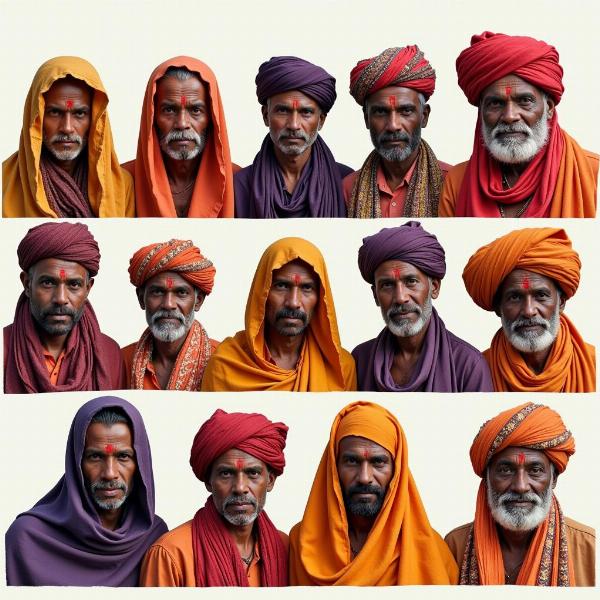The term “ghunghat meaning in hindi” often leads to a search for understanding the tradition of veiling in Indian culture. It’s more than just a piece of cloth; it’s a complex symbol with varying interpretations across different regions and communities in India. This article delves into the meaning, history, and evolving perceptions of the ghunghat.
Understanding the Ghunghat: More Than Just a Veil
The word ghunghat (घूँघट) in Hindi refers to the veil worn by women, typically covering their head and face. While often translated simply as “veil,” its significance runs much deeper, interwoven with social customs, religious beliefs, and historical context. It’s a practice seen across various communities in India, though the reasons behind it and the manner in which it’s observed can differ significantly.
Historical and Regional Variations of the Ghunghat
The history of the ghunghat is complex and debated. Some scholars trace its origins back to ancient times, associating it with notions of modesty and protection. Others point to later influences, including the arrival of Muslim rulers in India. Regardless of its exact origins, the ghunghat became integrated into various cultural practices across the subcontinent. In some regions, it’s a symbol of respect for elders, while in others, it’s seen as a mark of marital status.
Ghunghat in North India
In North India, the ghunghat is often more prevalent, particularly in rural areas. It’s commonly associated with newlywed brides and is considered a symbol of their new status and a mark of respect for their husband’s family.
Ghunghat in South India
The practice is less common in South India, and when observed, it may have different connotations. For instance, in some communities, it’s worn during religious ceremonies or as a sign of respect for deities.
 Regional variations of ghunghat
Regional variations of ghunghat
The Evolving Perception of the Ghunghat in Modern India
Today, the practice of wearing a ghunghat is undergoing significant change. While still prevalent in certain communities, many women are choosing to abandon the tradition, viewing it as a symbol of oppression and restriction. This shift is particularly evident in urban areas and among educated women who are increasingly challenging traditional gender roles.
Ghunghat and Women’s Empowerment
The debate surrounding the ghunghat often centers around women’s empowerment. Critics argue that it limits women’s visibility and participation in public life, reinforcing patriarchal norms. Others maintain that it’s a matter of personal choice and cultural expression, and women should have the freedom to choose whether or not to wear it.
Ghunghat: A Symbol of Tradition and Change
The ghunghat, in its many forms and interpretations, represents a complex interplay of tradition and change in Indian society. It’s a practice that continues to evolve as women negotiate their identities within a rapidly changing world.
Conclusion: Understanding the Nuances of Ghunghat
The term “ghunghat meaning in hindi” encompasses a rich cultural history and a complex present. It’s a practice that’s far more nuanced than a simple definition can convey, reflecting the diverse traditions and evolving social dynamics within India.
FAQ:
- What is the literal meaning of ghunghat in Hindi? It refers to the veil worn by women, covering their head and face.
- Is ghunghat practiced all over India? While seen across various regions, its prevalence and significance vary.
- Why do women wear a ghunghat? Reasons include modesty, respect for elders, marital status, and religious beliefs.
- Is the practice of ghunghat declining? Yes, particularly in urban areas and among educated women.
- Is ghunghat considered oppressive? This is a subject of ongoing debate, with varying perspectives.
- Is wearing a ghunghat a personal choice? Many argue that it should be a matter of personal choice and cultural expression.
- What does the future hold for the tradition of ghunghat? It will likely continue to evolve as Indian society undergoes further social and cultural changes.
Meaning-Hindi.in is your trusted partner for professional Hindi translation services, specializing in business, legal, technical, website localization, educational, and specialized content. Our expertise covers a wide range of fields, ensuring accurate and culturally sensitive translations. For high-quality Hindi translations tailored to your specific needs, contact us at [email protected] or call us at +91 11-4502-7584. Meaning-Hindi.in is committed to bridging language barriers and facilitating effective communication.